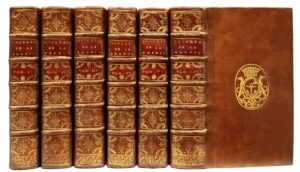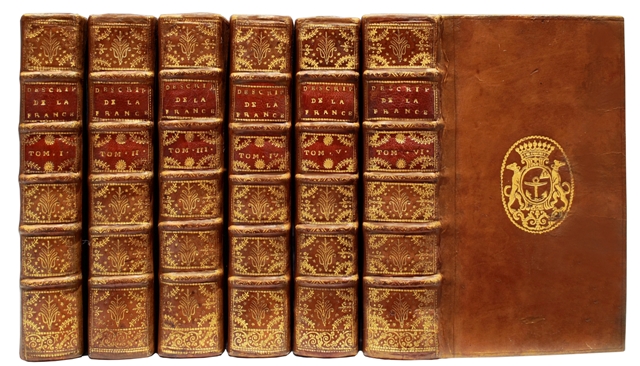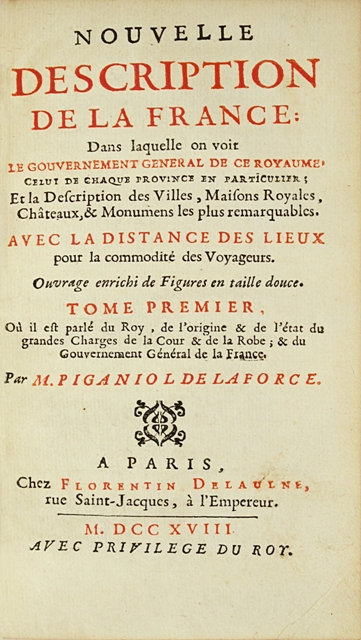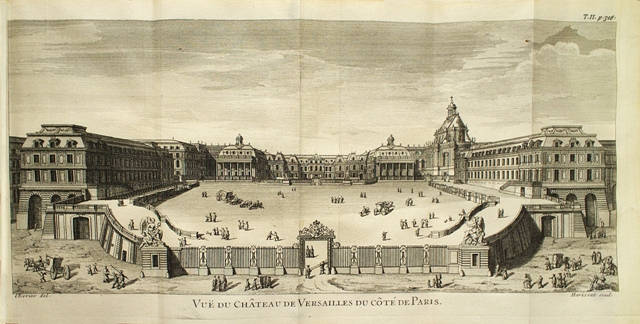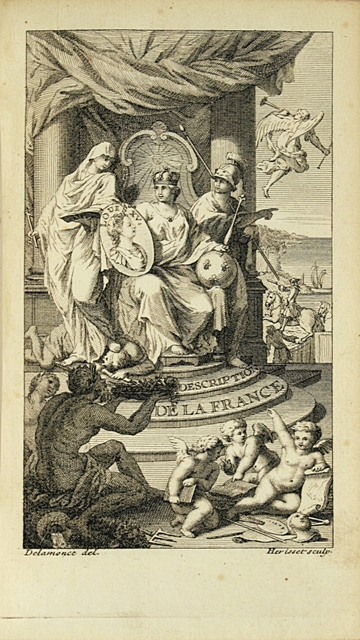PIGANIOL DE LA FORCE, J. A. Nouvelle Description de la France : Dans laquelle on voit le gouvernement general de ce royaume, celui de chaque province en particulier ; Et la Description des Villes, Maisons Royales, Châteaux, & Monumens les plus remarquables. Avec la distance des lieux pour la commodité des Voyageurs. Ouvrage enrichi de Figures en taille douce. Paris, Florentin Delaulne, 1718.
6 parts in 6 12mo volumes [164 x 93 mm] of: I/ (1) bl.l., (1) title l., 10 pp., (15) ll., 462 pp., (28) ll., 1 frontispiece, 4 folding engravings out of pagination; II/ (1) bl.l., (9), 504 pp., (31) ll., 7 folding engravings out of pagination; III/ (1) bl.l., (5), 524 pp., (27) ll., 1 folding engraving out of pagination; IV/ (1) bl.l., (6), 527 pp., (30) ll., 1 folding engraving out of pagination; V/ (1) bl.l., (6), 574 pp., (29) ll. ; VI/ (1) bl.l., (6), 682 pp., (38) ll., 1 folding engraving out of pagination. Small hole in 1 p. of part I affecting a few words. Bound in full light brown calf, gilt coat of arms on the center of the covers, spines ribbed and decorated with gilt fleurons, red morocco lettering pieces, gilt inner border, red edges. A few light restorations on the joints. Contemporary binding.
Second first edition enlarged with Piganiol de la Force’s main work, which was, when it was published, the best of the works written on that matter; he had been largely written after the notes taken by the provinces’ intendants for the instruction of the Duke of Burgundy. Hérissant, Bibl. Physique de la France, p. 36.
The author gives a precise and lively picture of France at that time. The work is illustrated with a frontispiece and with 14 engraved figures and plans by Hérisset after Delamonce.
“Piganiol de la Force belonged to a noble family, he was appointed vice-governor of the count of Toulouse’s pages. He devoted himself with passion to the geography and history of France, and undertook several travels which helped him give an accurate and complete description of the different provinces. His works were very successful, this success mostly being attributed to the general respect felt for the author. ‘He joins, wrote about him Lenglet-Dufresnoy, to a deep and varied knowledge a great integrity, a lot of honor and all the good manners of a courtier’.”
Precious copy of Samuel Bernard, Louis XIV and Louis XV’s famous financier. It is perfectly preserved in nice contemporary bindings in light brown calf with his arms.
“Samuel Bernard (1651-1739) gained under the Chamillart ministry a huge fortune, evaluated to thirty-three millions in capital; he helped several times the government and lent considerable amounts to Louis XIV and Louis XV. The first of these two monarchs hadn’t deigned, back during the war of the Spanish Succession, to personally speak to Samuel Bernard, and to flatter him. He thought he would deserve the same honor from Louis XV: “When we need people, it is the least, he says, to ask ourself for it.” He was indeed presented to the king, who talked to him with benevolence, and asked a lord at court to make him visit the royal house. We laugh, it is true, of his slightly bourgeois manners; which didn’t prevent him from giving the millions asked. Bernard was charitable, and lent sometimes considerable amounts without knowing if he would be repaid. He lent more than 10 millions, and among the borrowers were mainly poor militaries. It isn’t proved that he was a Jew, as it was said. He was ennobled and made knight. He was superstitious, it is said, and thought that his life was linked to the one of one black hen: he indeed died at the same time as this bird”.
See less information
